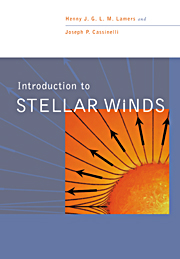
-
Select format
-
- Publisher:
- Cambridge University Press
- Publication date:
- June 2012
- June 1999
- ISBN:
- 9781139175012
- 9780521593984
- 9780521595650
- Dimensions:
- (247 x 174 mm)
- Weight & Pages:
- 0.92kg, 454 Pages
- Dimensions:
- (247 x 174 mm)
- Weight & Pages:
- 0.72kg, 456 Pages
- Subjects:
- Physics and Astronomy, Astrophysics
You may already have access via personal or institutional login- Subjects:
- Physics and Astronomy, Astrophysics
Book description
This long-awaited graduate textbook, written by two pioneers of the field, is the first to provide a comprehensive introduction to the observations, theories and consequences of stellar winds. The rates of mass loss and the wind velocities are explained from basic physical principles. This book also includes chapters clearly explaining the formation and evolution of interstellar bubbles, and the effects of mass loss on the evolution of high- and low-mass stars. Each topic is introduced simply to explain the basic processes and then developed to provide a solid foundation for understanding current research. This authoritative textbook is designed for advanced undergraduate and graduate students and researchers seeking an understanding of stellar winds and, more generally, supersonic flows from astrophysical objects. It is based on courses taught in Europe and the US over the past twenty years and includes seventy problems (with answers) for coursework or self-study.
Reviews
‘This is an enlightening book, full of vivid physics. It fills a long-standing gap in the astrophysical literature and will stand as the foundation of the rapidly growing field of stellar winds.’
Norbert Langer - University of Potsdam
‘… for those interested in a deeper theoretical understanding of stellar winds, the book is certainly to be recommended.’
Rainer Wieler Source: Meteroritics & Planetary Science
‘This is an excellent textbook. … an invaluable resource … certainly a requisite purchase for anyone starting a study of stellar winds.’
Raman Prinja Source: The Observatory
‘Stellar winds are ubiquitous, but their properties and mechanisms span an enormous range. This badly needed book by two well known researchers brings together theory and observation to provide an excellent, integrated treatment of a fascinating subject.’
Hollis R. Johnson - Indiana University
Contents
Metrics
Altmetric attention score
Full text views
Full text views help Loading metrics...
Loading metrics...
* Views captured on Cambridge Core between #date#. This data will be updated every 24 hours.
Usage data cannot currently be displayed.
Accessibility standard: Unknown
Why this information is here
This section outlines the accessibility features of this content - including support for screen readers, full keyboard navigation and high-contrast display options. This may not be relevant for you.
Accessibility Information
Accessibility compliance for the PDF of this book is currently unknown and may be updated in the future.


